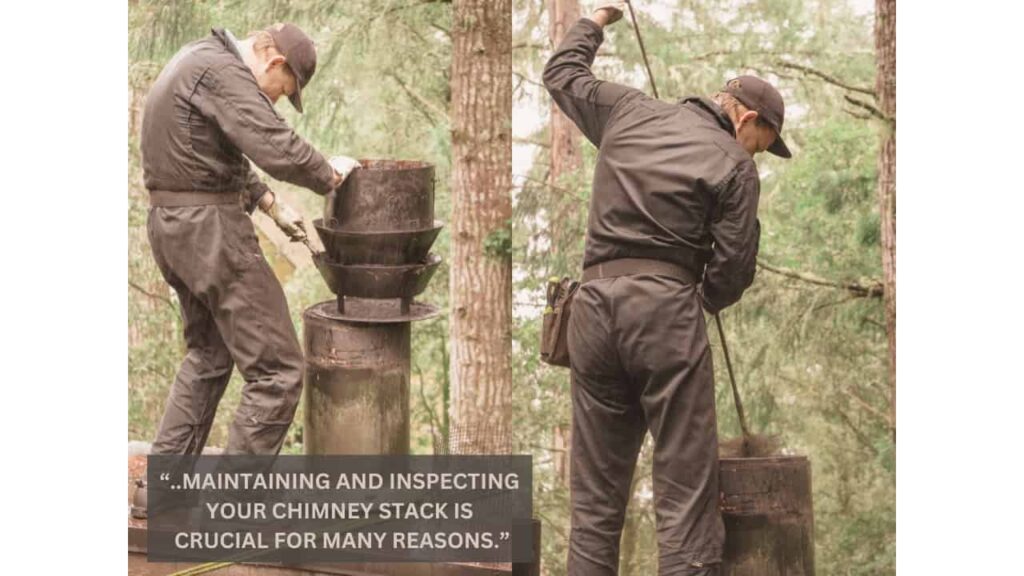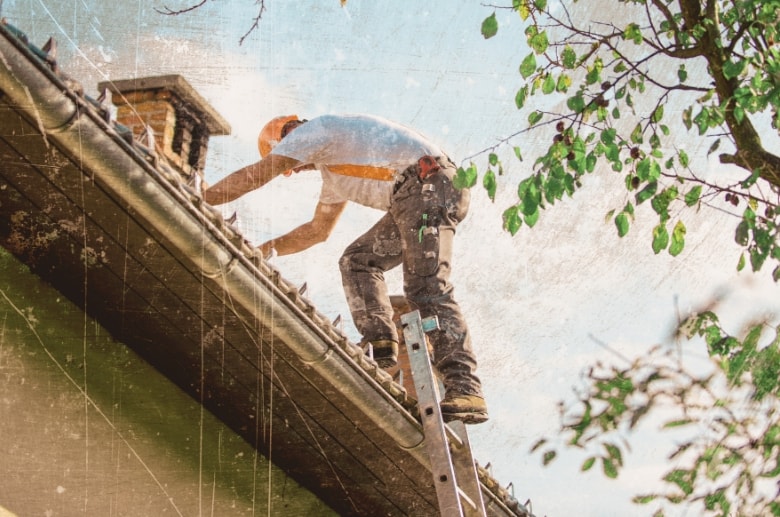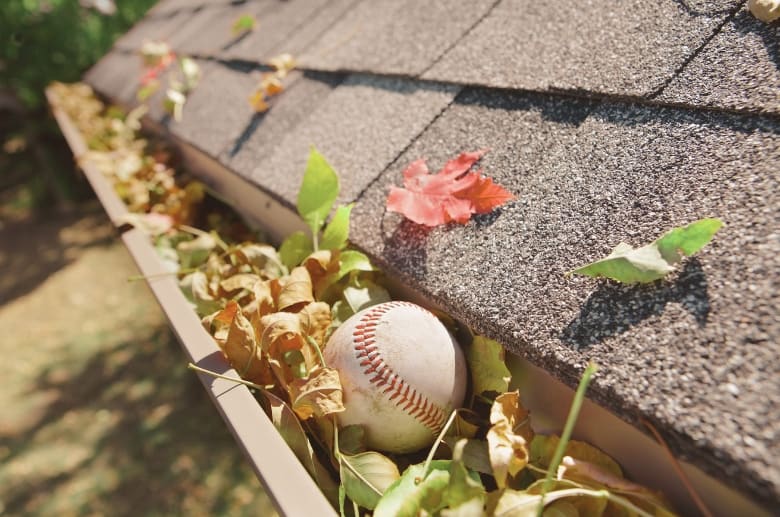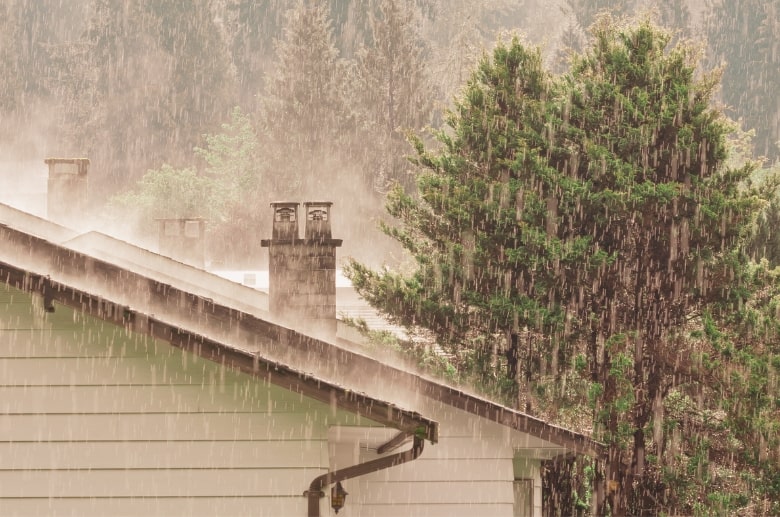Chimney maintenance goes a long way beyond sustaining good aesthetics. It’s a crucial task that protects your home, ensuring it remains a safe and warm place to live. Proper maintenance practices improve your chimney’s functionality, extend its durability, and minimize the chances of incurring expensive repairs.
This comprehensive guide walks you through the fundamental aspects of chimney stack maintenance and inspection that are essential for every homeowner to understand.
Let’s begin!
Why Chimney Stack Maintenance and Inspection is Important
Maintaining and inspecting your chimney stack is crucial for many reasons. Below are some of them:

Ensuring Safety for Your Home and Family
Creosote buildup, debris accumulation, and cracks in the flue can lead to dangerous fire hazards or carbon monoxide leaks. Ensuring all parts of your chimney are in optimal condition provides a secure environment for you and your loved ones.
——
Do You Need to Hire Chimney & Fireplace Expert?
Get free quotes from qualified experts near you. No commitment required!
——
Preventing Costly Repairs Down the Line
A neglected chimney can suffer from structural damage, compromising its functionality and draining your finances. One common architectural feature, the chimney corbel, can deteriorate over time if not properly maintained. This protruding ledge on the chimney often requires special attention to prevent potential issues.
Investing in regular chimney service means avoiding these expensive consequences by promptly identifying and addressing emerging issues.
Maintaining Energy Efficiency
A clogged or improperly functioning chimney can cause inefficient burning and reduced heating system performance, leading to increased energy consumption and higher bills. Regular maintenance ensures your chimney operates at its best, keeping your home cozy without straining your resources.
Common Chimney Stack Maintenance Tasks
Regular maintenance ensures your chimney stack’s long-lasting performance and functionality. Here are two primary categories of maintenance tasks that should not be overlooked:
1. Routine Maintenance
Routine maintenance is your first defense to keep your chimney in excellent condition. Ideally, you should perform these tasks annually or as often as a professional recommends. Here are some key tasks to include in your routine maintenance checklist:
Clearing Debris from the Top Of Your Chimney Stack

Clearing debris from the top of your chimney stack is an important part of chimney maintenance to ensure safety and efficient ventilation. Here’s a step-by-step guide on how to do it:
- Choose a clear and calm day to perform this task.
- Place a ladder on a stable and level surface, ensuring it’s at a safe angle against the chimney. The ladder should extend at least three feet above the chimney crown for stability.
- Put on a safety harness and attach the rope to a secure anchor point, like a chimney bracket or another stable structure.
- Climb up the ladder carefully and maintain three points of contact (two feet and one hand) at all times.
- Carefully examine the crown or cap for debris, leaves, twigs, and other foreign objects. Use a flashlight if necessary to get a better view.
- Remove loose debris from the chimney crown or cap using your gloved hands.
- While up there, inspect the chimney crown or cap for signs of damage, cracks, or deterioration.
- After clearing the debris, clean the area around the chimney crown or cap to ensure nothing is left behind that could potentially fall into the chimney.
Checking the Cap and Crown
A damaged cap or crown can allow water to seep into your home, leading to structural issues. Inspect the chimney cap and crown for wear, cracks, or damage. If you spot any damage, replace the cap or repair the crown for optimum functioning.
Ensuring the Flue Liner Is in Good Condition
A clear and intact flue liner is essential for safe and efficient chimney operation. Examine the flue liner for obstructions, creosote buildup, or cracks. If you see any of these, contact a chimney sweep for assistance.
Roof Drainage

Ensure the area around the chimney is properly graded to allow water to flow away from the base. This will help prevent water pooling and avoid water damage and deterioration of your roofing materials.
Sealing Masonry
Sealing masonry, such as a brick chimney, protects it from moisture damage and maintains its structural integrity. Here are some actionable insights on how to properly seal masonry:
- Clean the entire masonry surface using a stiff brush, mild detergent, and water.
- Check the masonry for any cracks, gaps, or loose bricks. Repair any structural damage before proceeding with sealing.
- Select a waterproof sealant specifically designed for masonry surfaces. Read the manufacturer’s instructions and recommendations for your specific product.
- Before applying the sealant to the entire chimney, it’s a good practice to test a small, inconspicuous area first to ensure compatibility and the desired finish.
- Follow the manufacturer’s instructions for the application method, whether brushing, rolling, or spraying.
- Again, follow the manufacturer’s recommended drying times, which may vary from a few hours to a few days.
- Keep the area protected from rain or moisture during this curing period.
- After the initial coat has dried, inspect the masonry for any missed spots or areas that may require additional sealing.
2. Advanced Repairs
Sometimes, your chimney may require more extensive repairs beyond routine maintenance. These are tasks that only experienced professionals should undertake. Here are some advanced repair tasks you might encounter:
Cracks and Brickwork Issues
Cracks in your chimney’s masonry or deteriorating brickwork and mortar can significantly compromise its stability and safety. However, timely intervention prevents these problems from escalating and causing potential hazards.
Ensure you seek the services of a skilled chimney technician for the job. They possess the know-how to assess the severity of these issues in chimneys and implement appropriate measures, such as repointing or rebuilding damaged sections.
Repairing or Replacing the Chimney Cap and Crown
Damaged or deteriorated caps and crowns can lead to water penetration, affecting the chimney’s interior and exterior. A chimney company can repair or replace these components, ensuring effective water protection and prolonging your chimney’s life.
Sealing Moisture Points and Addressing Leaks
Leakage in and around your chimney can compromise structural integrity and even harm your indoor environment. Expert chimney contractors employ specialized techniques to locate and seal moisture entry points, safeguarding your home from potential harm and ensuring a dry, secure living space.
Flue Relining for Enhanced Safety
Over time, the flue liner within your chimney may deteriorate due to exposure to high temperatures, corrosive byproducts, and moisture. Reputable professionals can recommend and execute flue relining, a critical project that ensures efficient ventilation, reduces fire risks, and enhances overall chimney safety.
——
Do You Need to Hire Chimney & Fireplace Expert?
Get free quotes from qualified experts near you. No commitment required!
——
Importance of Regular Chimney Stack Inspections
Regular chimney inspections are crucial for home safety and fireplace efficiency. They provide vital information about your chimney’s condition, enabling timely maintenance to prevent hazards.
The following section looks at the different types of chimney stack inspections.
Types of Chimney Stack Inspections
Chimney stack inspections come in various forms, tailored to different levels of scrutiny and analysis. Here are the two common types:
Basic Visual Check
This preliminary inspection visually assesses the chimney’s exterior and accessible interior components. It helps identify obvious issues like cracks, signs of wear, or debris buildup.
In-depth Inspection Involving Minor Modifications for Access
This comprehensive examination entails going beyond the surface and may require minor modifications to access concealed areas of the chimney.
It entails thoroughly evaluating the flue, liner, and other internal elements. This type of inspection involves a team using specialized tools and equipment.
Optimal Times for Chimney Stack Inspections
Knowing when to schedule chimney inspections can make a significant difference in maintaining a safe and efficient fireplace system. Here are the optimal times you should consider chimney stack inspections:
After Severe Weather

Harsh weather conditions like storms, heavy rain, intense snow, or extreme cold can impact your chimney’s structural integrity. Post-weather inspections help assess potential damage or debris accumulation that might compromise your chimney’s function.
Before the Peak Fireplace Season
Inspecting your chimney stack before the colder months set in ensures your fireplace is ready to provide warmth and comfort. It also helps you detect possible issues that might be challenging to fix during these times.
Observable Performance Changes or Anomalies
An inspection is warranted if you notice unusual performance from your fireplace, like increased smoke or strange odors. These anomalies could indicate blockages, creosote buildup, or other issues that require attention before they damage your property.
Signs of Chimney Stack Problems
Your chimney stack can sometimes exhibit signs of trouble that require immediate attention. Here are some signs that you should pay attention to and what they signify:
Cracks in Masonry
Cracks in the chimney’s masonry signify structural issues, water infiltration, or deteriorating materials. Small cracks worsen over time, leading to more significant problems if left untreated.
Leaking Water or Stains
Water stains on the ceiling or walls near your chimney are common signs of leaks. Most leaks result from damaged flashing, a compromised chimney crown, or deteriorated masonry. Fixing this issue prevents water damage in your home.
Excessive Smoke
If your home becomes smoky during fireplace use, you might have a blocked chimney or poor ventilation. Blockages due to debris can obstruct airflow and pose fire hazards.
DIY vs. Professional Chimney Stack Maintenance
Maintaining your chimney stack requires deciding whether to handle the tasks or hire a business specializing in chimneys. Both options have their benefits and downsides, and it’s important to know when to do it yourself and when to seek expert help for a safe and well-maintained chimney.
Let’s look at the pros and cons of DIY chimney stack maintenance:
Pros
- It is cost effective
- Provides immediate action
- It helps you gather experience
Cons
- Limited expertise
- Safety risks, especially when handling complex tasks
- Incomplete assessment due to limited knowledge
When to DIY and When to Call a Professional
Deciding between handling chimney maintenance on your own or hiring a professional depends on several factors. Here are scenarios where a do-it-yourself approach might be worth considering:
When You Have Vast DIY Experience
You might confidently handle several tasks if you’re a DIY enthusiast with a strong understanding of chimney systems and maintenance procedures. These include basic tasks like cleaning, visual inspections, and minor repairs.
When Doing Minor Repairs
Simple tasks such as replacing a chimney cap, fixing minor cracks, or applying a waterproof sealant to masonry might be well-suited for DIY. However, you must acquire the necessary tools, information, and techniques.
Applying Sealant or Paint
Applying a waterproof sealant or a fresh coat of heat-resistant paint to the chimney exterior can be relatively straightforward. However, you should know the materials and techniques to do this effectively.
There are instances when professional expertise is strongly recommended. They include the following:
Structural Repairs
Skilled contractors should always be entrusted with significant cracks, extensive brickwork issues, or chimney rebuilding. This will help ensure safety and proper structural integrity.
Creosote Removal
Professionals possess the expertise and tools to remove creosote buildup safely. Creosote is hazardous because it contains compounds that pose significant risks to your health and your chimney’s integrity.
Flue Liner Assessment
Professionals are equipped to assess and address issues with flue liners, a critical component for safe chimney operation.
——
Do You Need to Hire Chimney & Fireplace Expert?
Get free quotes from qualified experts near you. No commitment required!
——
Cost of Chimney Stack Maintenance
You can expect to pay an average of $150 to $350 for routine chimney maintenance, including basic cleaning and inspection. However, major repairs or structural issues can range from $500 to $7,000 or more, depending on the scope of the work required.
Get in touch with a chimney sweep for a firm estimate on the cost of your projects.
Other factors affecting chimney stack maintenance costs include:
- Location of your chimney
- Chimney size and complexity
- The severity of repairs needed
- Material and equipment
Conclusion
Proactive chimney stack maintenance ensures your home’s safety, efficiency, and longevity. Addressing issues like creosote buildup, cracks, or leaks will help prevent potential hazards and preserve the charm and functionality of your chimney.
Also, regular checks and professional consultations ensure thorough assessments that enable you to enjoy the comfort of your fireplace with peace of mind. Ensure you contact us for all your maintenance and inspection needs.






